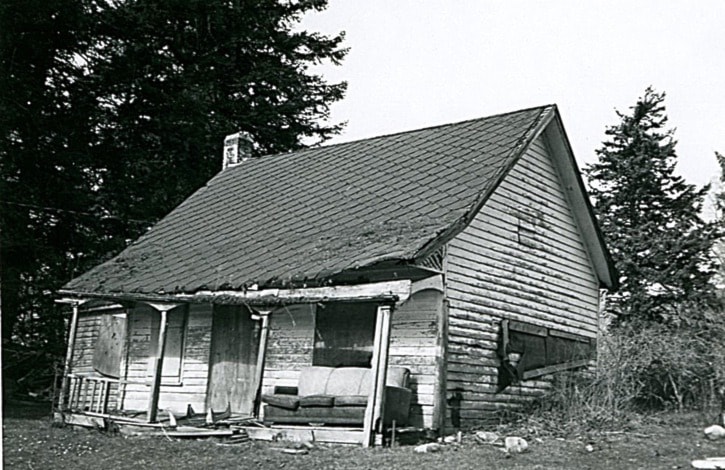The trimly kept whitewashed cottage seen at the museum on Phillips Road today is scarcely recognizable as the image in the 1976 photo below. Moss Cottage originally stood on the grounds where the Baptist Church now serves its congregation.
Built in 1869/70 by James Welsh for his new bride Mary Ellen Flynn, the cottage faced towards the initial pioneer structure of Woodside, home of John Muir, Sr. and his wife Ann Miller. When a road to Sooke was built in 1872, it stopped at the gates of Woodside. One of Sooke’s earliest settlers, James Welsh, kin to the Muirs, had 10 happy years at Moss Cottage, but when Mary Ellen died in childbirth in 1880, his world fell apart.
Of the four surviving Welsh children, the eldest daughter, Esther, was brought up in Victoria, and became Mrs. Moore. Son Willie was raised by his Muir relatives, while daughter Anne went to the Order of the Sisters of St. Ann in Victoria where she eventually became Sister Mary Mildred, Mother Provincial. It is understood that another child was adopted by a nurse and taken to Chicago.
William Welsh grew up to become an upstanding Sooke citizen and several generations of Welshes have taken their place in Sooke’s developing world. His eldest son Ernie Welsh, owner of Moss Cottage at the time this photo was taken, gave the pioneer home to the museum, and it was dismantled, moved to Phillips Road and restructured in 1977.
Today, tours of Moss Cottage allow visitors to see the lifestyle of 1902, when the cottage was home to another Muir kin, Matilda, a daughter of Michael Muir of Burnside. Married to an English immigrant, Jack Gordon, Matilda had moved into the little cottage on the farm when her husband had died of consumption.
Vacant in the 1930s, after it was no longer needed by the Gordons, Moss Cottage has provided shelter in turn, to many immigrant families. Hugh and Olive Wadams, Don and Gladys Lowe, Henk and Anne Van Ek, Jack and Allie Perestam, Adrian and Kay Koolman, Fred and Jean Newman and Rocky and Jean Jackson had all been tenants prior to the building standing sad and forlorn.
Elida Peers
Historian, Sooke Region Museum
